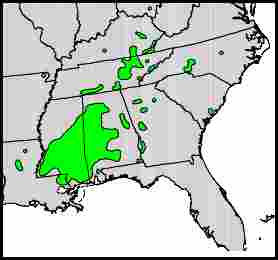Bigleaf Magnolia
(Magnolia macrophylla)
The Bigleaf Magnolia is a medium-size deciduous tree notable for its very large leaves and flowers. The giant leaves can grow up to 30 inches long and the flowers can be a foot wide. Such large sizes definitely make an impact, and a mature specimen is sure to command attention.
Surprisingly, the tree itself doesn't get especially big, usually no more than 50 feet tall. Most plants have a thick trunk and a rounded crown of stout branches. The fragrant flowers, which appear in late spring or early summer, have six white petals surrounding a yellow and purple center. Unfortunately they are often partly hidden in the foliage and thus hard to see from ground level. The fruit is a cone-shaped pod containing large red or scarlet seeds.
The large leaves and blossoms are an indication that this is a primitive species. In fact the magnolias are among the oldest of all surviving tree families. Their blossoms, unlike those of more recently-evolved trees, are pollinated by beetles, which pre-date bees and butterflies. A strong fragrance helps attract the beetles.
The Bigleaf Magnolia is found from southern Ohio south to the Gulf Coast, but isn't common anywhere. In cultivation it has proven to be hardy in much of the north. It is somewhat shade-tolerant, but can also grow in full sunlight. It needs a moist loamy soil and can suffer during droughts.
If possible, you should put this plant in a sheltered spot, because strong winds can tear the leaves and make them unsightly. The tree also has shallow roots which make it difficult to garden under, and fallen leaves and seed cones can create a litter problem. For these reasons it might be best-suited to a natural area.
If you want a somewhat smaller but similar tree, consider planting an Ashe Magnolia (Magnolia ashei), which at one time was classified as a subspecies of Bigleaf Magnolia. This plant also has very large leaves and flowers, but is usually less than 30 feet tall. It blooms at an early age, sometimes when only three feet tall. A very rare species found near the Gulf Coast, it may not do well in northern regions.
Other Information
Scientific Name: Magnolia macrophylla
Common Names: Bigleaf Magnolia, Silverleaf Magnolia
Plant Type: Mid-size deciduous tree
Height: 40 to 60 feet
Cultivation Zones: 5B - 8
Native Habitat: Moist soils, usually in valleys or ravines
Native Range: South-central U.S. to Gulf Coast, with localized populations in southern Ohio and Arkansas. See distribution map below.
Distribution Map

Range Map Source: U.S. Forest Service. (See General Note C)
Conservation Status: NatureServe lists Magnolia macrophylla as Critically Imperiled in Arkansas and Virginia; Imperiled in North Carolina and Ohio; and Vulnerable in Georgia. Officially the species is classified as Endangered by Arkansas and Ohio.
Cultivation: Give this plant moist well-drained soil, and water it during droughts. A mulch will help keep the soil moist. If possible, put it in a sheltered spot where strong winds are less likely to shred the leaves. Go to Cultivation for more information.
Plant Sources: Possible suppliers include Shooting Star Nursery, Wayside Gardens, Woodlanders, Forest Farm, Overhill Gardens, and Nearly Native Nursery. A cultivar called "Whopper" has even larger leaves and flowers than the typical plant. For links to the mentioned suppliers, go to Sources of Plants.
|

